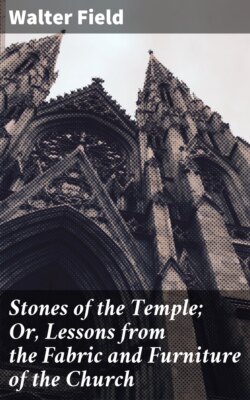Читать книгу Stones of the Temple; Or, Lessons from the Fabric and Furniture of the Church - Field Walter - Страница 6
На сайте Литреса книга снята с продажи.
LICH-STONES
ОглавлениеTable of Contents
"Good morning, Mr. Acres, and a happy Easter-Tide to you. This is indeed a bright Easter sun to shine on our beautiful Lich-Gate at its re-opening. I little thought on what good errand you were bent when last we parted at this spot. Hardly however had I reached my door when William Hardy came with great glee to tell me you had engaged his services for the work. May God reward you, sir, for the honour you have shown for His Church."
"And an old man's blessing be upon you, sir, if you will let Old Matthew say so; for the Church-gate is dearer to me than my own, seeing it has closed upon my beloved partner, and the dear child God gave us, and my own poor wicket shuts on no one else but me now."
"Thank you heartily, honest Matthew, and you too, sir," replied the squire, giving to each the hand of friendship; "I am rejoiced that what has been done pleases you so well. The restored Gate is in every respect like the original one, even to the simple little cross on the top of it. I have added nothing but the sentence from our Burial Office, 'Blessed are the dead which die in the Lord,' which you see over the arch, and which I hope will bring comfort to some, and hope to all who read it. But the work would never have been done by me, Mr. Vicar, had you not so interested Matthew and myself in these Lich-Gates when last we met. And so, as you see, your good words have not been altogether lost, I hope you will kindly to-day continue the subject of our last conversation."
"Most gladly will I do so; and as I have already spoken of the general purpose and utility of these Lich-Gates, I will now say a little about their construction and arrangement.
"Their most common form, as you know, is a simple shed composed of a roof with two gable ends, covered either with tiles or thatch, and supported on strong timbers well braced together. But they are frequently built of stone, and in the manner of their construction they greatly vary. At Burnsall there is a curious arrangement for opening and closing the gate. The stone pier on the north side has a well-hole, in which the weight that closes the gate works up and down. An upright swivel post or 'heart-tree,' (as the people there call it,) stands in the centre, and through this pass the three rails of the gate; an iron bent lever is fixed to the top of this post, which is connected by a chain and guide-pulley to the weight, so that when any one passes through, both ends of the gate open in opposite directions. The Gate at Rostherne churchyard, in Cheshire, is on a similar plan. At Berry-harbour is a Lich-Gate in the form of a cross. At only one place, I believe—Troutbeck, in Westmoreland—are there to be found three stone Lich-Gates in one churchyard. Some of these gates have chambers over them, as at Bray[8], in Berkshire, and Barking[9], in Essex. At Tawstock there is a small room on either side of the gate, having seats on three sides and a table in the centre. It seems that in this, as in some other cases, provision is made either for the distribution of alms, or for the rest and refreshment of funeral attendants. It was once a common custom at funerals in some parts, especially in Scotland[10], to hold a feast at the Church-gate and these feasts sometimes led to great excesses: happily they are now discontinued, but the custom may help to point out the purpose for which these Lich-Gate rooms were sometimes erected. In Cornwall it is not customary to bear the corpse on the shoulders, but to carry the coffin, under-handed, by white cloths passed beneath and through the handles[11] and this partly explains the peculiar arrangement for resting the corpse at the entrance to the churchyard, common, even now, in that county, and which is called the Lich-Stone. The Lich-Stone is often found without any building attached to it, and frequently without even a gate. The Stone is either oblong with the ends of equal width, or it is the shape of the ancient coffins, narrower at one end than the other, but without any bend at the shoulder. It is placed in the centre, having stone seats on either side, on which the bearers rest whilst the coffin remains on the Lich-Stone. When there is no gate, the churchyard is protected from the intrusion of cattle by this simple contrivance:—long pieces of moor-stone, or granite, are laid across, with a space of about three inches between each, and being rounded on the top any animal has the greatest difficulty in walking over them, indeed a quadruped seldom attempts to cross them.
"Lich-Stones are—though very rarely—to be found at a distance from the churchyard; in this case, doubtless, they are intended as rests for the coffin on its way to burial.
"At Lustleigh, in Devonshire, is an octagonal Lich-Stone called Bishop's Stone, having engraved upon it the arms of Bishop Cotton[12]. It seems not unlikely that the several beautiful crosses erected by King Edward I. at the different stages where the corpse of his queen, Eleanor[13], rested on its way from Herdeby in Lincolnshire to Westminster, were built over the Lich-Stone on which her coffin was placed. And now, my kind listeners, I think I have told you all I know about Lich-Stones."
